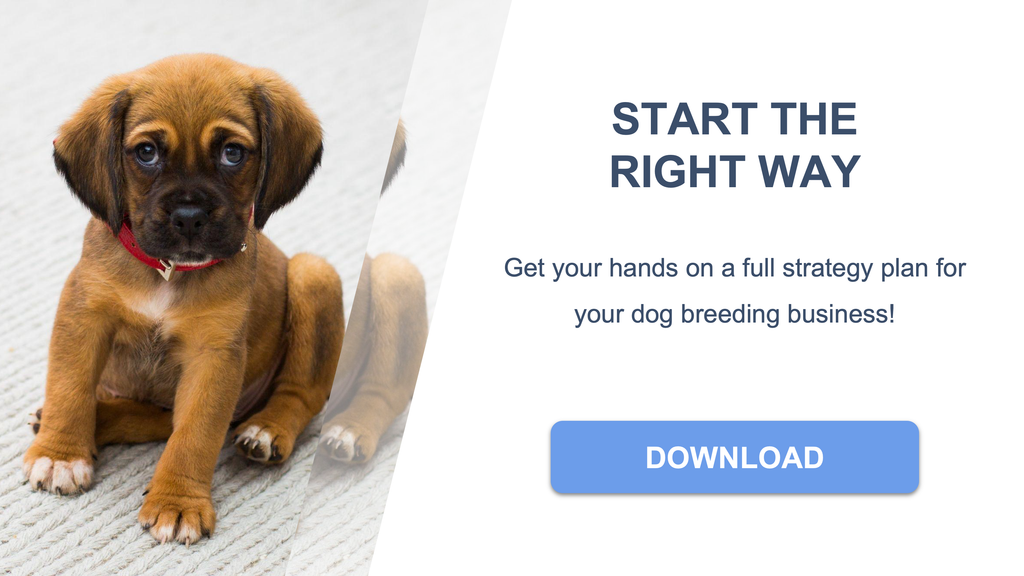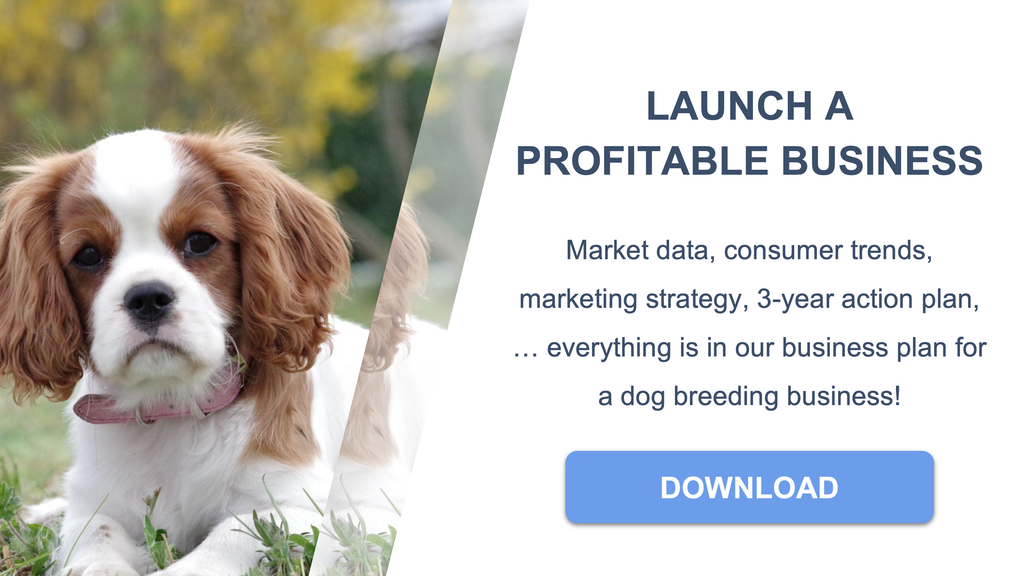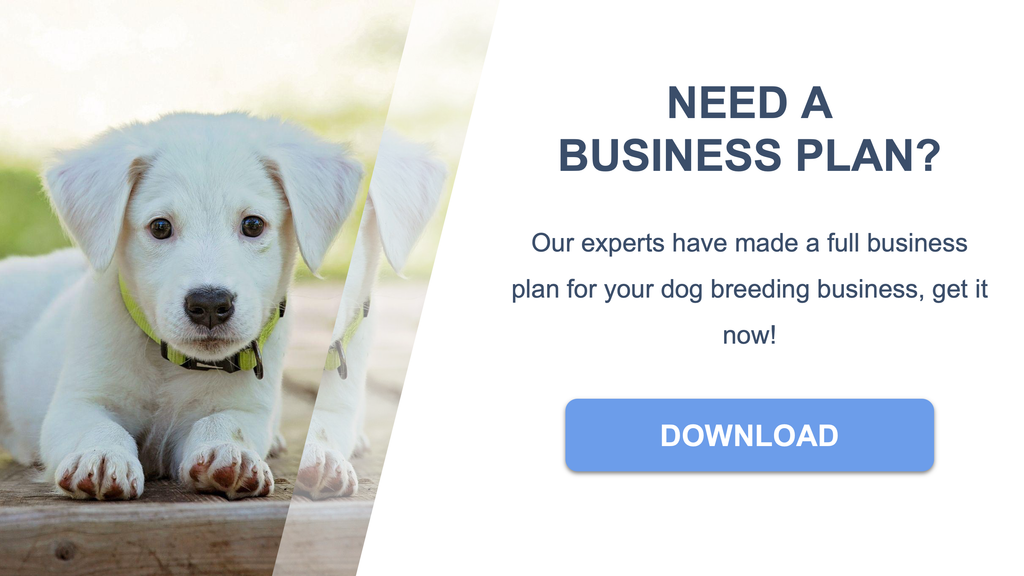This article was written by our expert who is surveying the industry and constantly updating the business plan for a dog breeder.

This guide explains today’s dog breeding market, with numbers and clear actions for new kennel owners.
It focuses on market size, growth hotspots, breed demand, costs, regulations, technology, risks, and concrete opportunities so you can plan a profitable dog breeding business from day one.
If you want to dig deeper and learn more, you can download our business plan for a dog breeder. Also, before launching, get all the profit, revenue, and cost breakdowns you need for complete clarity with our dog breeder financial forecast.
The global dog breeding industry is valued at about $11.5 billion in 2025, growing roughly 8% per year since 2020, with North America leading and Asia-Pacific accelerating. Demand is shifting toward health-tested purebreds and designer crosses, stronger compliance, and digital-first sales.
Profitability hinges on breed selection, verified health quality, transparent marketing, and tight cost control on veterinary care, licensing, transport, and facilities—areas where prices have been trending upward.
| Theme | Key 2025 Takeaways for a Dog Breeding Business | What to Do Next |
|---|---|---|
| Market Size & Growth | $11.5B global value in 2025; ~8% CAGR over the last five years; >35% cumulative growth since 2021. | Size your local market and set sales targets aligned to 8%+ growth baselines. |
| Regional Hotspots | North America ~41% share; APAC ~20% and fastest-growing; Europe ~15%; Brazil and broader LATAM rising. | Prioritize domestic demand; explore APAC/LATAM partners for exports with strong health documentation. |
| Breed Demand | French Bulldog, Labrador, Golden, German Shepherd, plus designer crosses (e.g., Labradoodle, Cockapoo). | Pick 1–2 core breeds + 1 designer line; publish genetic/health test results. |
| Pricing & Spending | Designer puppies commonly $1,500–$4,000; rising spend on health checks, training, and transport. | Bundle vet checks & early training; offer transparent price sheets and contracts. |
| Regulation & Welfare | Stronger licensing, inspections, and traceability; enforcement tightening; ethical scrutiny increasing. | Document compliance; schedule audits; publish welfare standards on your website. |
| Digital Sales | Social media and marketplaces drive discovery and conversion; scams and unregulated sellers exist. | Use verified platforms; invest in video, vet certificates, buyer screening, and contracts. |
| Costs & Margins | Veterinary, genetic tests, facilities, licensing, transport, and marketing are trending up. | Lock in vet partnerships; forecast litters; maintain a 12-month cost calendar. |
| Adoption Impact | Rescue/adoption campaigns dampen some commercial sales; more purebreds appear in shelters. | Differentiation via health guarantees, temperament, and lifetime support. |
| Technology | Genetic testing, AI, reproductive tech, management software improve outcomes and trust. | Adopt DNA tests; track COI; use breeding/CRM software and transparent records. |

What is the global market size now, and how has it changed in five years?
The dog breeding industry is valued at about $11.5 billion in 2025 after growing steadily for five years.
Growth averaged roughly 8% per year since 2020, delivering more than 35% expansion compared with 2021 baseline estimates. North America holds the largest share, while Asia-Pacific has accelerated with rising pet ownership and disposable income.
Designer and health-tested purebreds drove premium pricing, while tighter compliance standards reshaped operations and costs. Demand remained resilient despite adoption campaigns because buyers value predictable health, temperament, and genetics.
You’ll find detailed market insights in our dog breeder business plan, updated every quarter.
| Year | Estimated Global Value | What Drove the Change |
|---|---|---|
| 2020 | ~$8.0B | Pandemic-era pet boom; early shift to online discovery and deposits. |
| 2021 | $8.3B | Formalization of breeding management; tighter welfare narratives. |
| 2022 | ~$9.0B | Premiumization; rising vet checks and genetic testing adoption. |
| 2023 | ~$9.8B | Designer crossbreeds trend; broader APAC demand. |
| 2024 | ~$10.7B | Compliance costs rise; digital marketplaces expand reach. |
| 2025 | $11.5B | 8%+ CAGR realized; higher pricing for certified, health-tested litters. |
| Regional Mix (2025) | NA 41% / APAC 20% / EU 15%+ | NA maturity; APAC momentum; EU stable but compliance-heavy. |
Which regions are growing fastest for purebred and designer dogs?
North America remains the largest market, while Asia-Pacific is the fastest-growing for purebred and designer dogs.
Within APAC, China, Japan, and India show strong demand and higher willingness to pay for verified health traits. South America—especially Brazil, Colombia, and Argentina—is expanding as middle-class pet ownership rises.
Export-minded kennels gain from cross-border interest if they meet vaccination, pedigree, and transport rules. Building partners with reputable transporters and vets is essential to protect puppies and reputation.
| Region/Country | 2025 Demand Signal | Action for Breeders |
|---|---|---|
| North America (US/Canada) | Largest share (~41%); strong designer and small-breed demand. | Maintain premium positioning; emphasize health proofs and contracts. |
| Asia-Pacific (China, Japan, India) | Fastest growth; rising incomes; interest in hypoallergenic crosses. | Prepare export compliance packs; local language pages and aftercare guides. |
| Europe (UK, DE, FR) | Stable; high scrutiny; stringent welfare rules. | Double down on documentation; audit-ready kennels. |
| Brazil | Rapid gains; urban pet ownership climbing. | Explore trusted agents; clear pricing and delivery timelines. |
| Mexico/Colombia/Argentina | Emerging demand; social sales channels popular. | Use verified marketplaces; vet transport partners. |
| Australia | Designer crosses popular; import restrictions strict. | Understand quarantine rules; plan long lead times. |
| Middle East (UAE, KSA) | Niche premium buyers; preference for small indoor breeds. | Offer concierge transport and white-glove handover. |
Which breeds are most popular, and how do rankings differ by market?
French Bulldogs, Labradors, Goldens, and German Shepherds lead globally, while designer crosses win attention in English-speaking markets.
The U.S., U.K., and Australia rank designer crosses (Labradoodle, Cockapoo) higher due to perceived hypoallergenic coats and temperament. Asia shows growing demand for compact breeds suitable for apartments and urban living.
Savvy kennels match breed selection to local housing and lifestyle patterns to shorten sales cycles. Publishing objective health and temperament data builds trust and pricing power.
| Market | Top Purebreds | Top Designer/Hybrid Lines |
|---|---|---|
| United States | French Bulldog, Labrador, Golden, German Shepherd | Labradoodle, Cockapoo, Goldendoodle |
| United Kingdom | Labrador, French Bulldog, Cocker Spaniel | Cockapoo, Cavapoo, Labradoodle |
| Australia | Labrador, Cavoodle (hybrid popular), Border Collie | Cavoodle, Labradoodle, Spoodle |
| Japan | Shiba Inu, Toy Poodle | Small doodle crosses |
| China | Poodle, French Bulldog | Toy-sized doodles, designer compacts |
| Brazil | Shih Tzu, Poodle | Mini doodles, Poodle mixes |
| Germany/France | German Shepherd, Labrador | Doodles less prominent but growing |
How is spending on puppies and related services changing year by year?
Average puppy prices and related service spending have risen each year with the shift to premium health assurances.
Designer puppies commonly list between $1,500 and $4,000 depending on breed, lineage, tests, and location, with buyers also funding vet checks, early training, and transport. Pet services—training, grooming, insurance—keep expanding as owners humanize their pets.
Transparent itemized quotes help justify pricing and reduce abandonment. Bundling initial vet care and starter training improves conversion and satisfaction.
| Spending Area | 2025 Typical Range/Trend | Implication for Breeders |
|---|---|---|
| Puppy Price | $1,500–$4,000+ depending on breed, tests, pedigree | Command premiums with certified health and clear contracts. |
| Health Checks | Comprehensive vet screenings rising in frequency | Pre-pay and include in bundle; display results. |
| Genetic Testing | More tests per breeding pair; higher buyer expectations | Adopt panel tests; publish COI and DNA results. |
| Training | Early obedience/house training packages growing | Offer starter sessions; partner with trainers. |
| Transport | Higher regulated costs and insurance for travel | Use licensed carriers; provide tracking and care reports. |
| Insurance | Rising uptake of pet insurance | Provide brochure/links; support claims docs. |
| Aftercare | Lifetime support and health guarantees valued | Offer hotline and written guarantee terms. |
How do regulations and animal welfare laws shape the market?
- Licensing, inspections, and record-keeping are stricter in North America and Western Europe, with heavier penalties for violations.
- Countries increasingly require health documentation, microchipping, and traceability to reduce illegal trade.
- Public databases and NGO investigations heighten scrutiny; some reports show high rates of observed violations among tracked breeders.
- Detailed contracts and transparent welfare standards are becoming the commercial norm for reputable kennels.
- Exporters must comply with vaccination schedules, quarantine rules, and airline/transport welfare protocols.
This is one of the strategies explained in our dog breeder business plan.
How important are online platforms and social media for sales?
Digital channels now drive discovery, trust-building, and conversion for dog breeders.
Serious buyers expect health certificates, parents’ test results, and temperament videos before paying deposits. Specialized marketplaces increase reach but require careful vetting to avoid scams and policy violations.
Top-performing kennels use consistent branding, education posts, and screening questionnaires to qualify buyers. Verified reviews and clear aftercare policies reduce chargebacks and disputes.
We cover this exact topic in the dog breeder business plan.
What are the main cost drivers for breeders, and how are they trending?
Veterinary care, genetic testing, facilities, licensing, transport, and marketing are the primary cost drivers, and most are trending upward.
Higher buyer expectations for health assurances and transparency add testing and documentation costs. Facilities and biosecurity upgrades respond to stricter welfare standards and inspection readiness.
Transport and insurance costs increase with more regulated logistics. Smart breeders offset inflation with bundled offerings and waitlist management.
| Cost Driver | 2025 Trend & Drivers | Cost Control Tactics |
|---|---|---|
| Veterinary Care | Up—more screenings, vaccinations, and preventive care | Vet partnerships; preventive protocols; group rates. |
| Genetic Testing | Up—broader panels and parent verification | Annual panels; negotiate bundles; publish results once. |
| Facilities & Biosecurity | Up—kennel upgrades, sanitation systems | Modular improvements; maintenance schedules. |
| Licensing & Compliance | Up—more inspections, documentation | Compliance calendar; digital record-keeping. |
| Transport & Insurance | Up—regulated carriers, longer routes | Approved carriers; shared routes; transparent fees. |
| Marketing & Sales | Stable-to-up—paid ads, video production | Organic content; testimonials; referral programs. |
| Feed & Supplies | Moderate inflation—quality nutrition expected | Bulk purchasing; standardized diets. |
How have adoption and rescue initiatives affected commercial breeding?
Adoption campaigns have softened demand in some segments and increased ethical scrutiny.
More purebreds and designer dogs appear in shelters, pointing to mismatches between buyer expectations and long-term commitments. Reputable breeders counter this by emphasizing health guarantees, temperament matching, and lifetime support.
Clear screening and education reduce returns and protect reputation. Offering rehoming support demonstrates responsibility and builds trust with buyers and regulators.
Get expert guidance and actionable steps inside our dog breeder business plan.
Which demographics drive demand for bred dogs?
Urban, middle-to-high income households, millennials, and Gen Z drive much of today’s puppy demand.
Smaller living spaces increase preference for compact, low-shedding breeds and calm temperaments. Dual-income households value bundled services (health checks, microchipping, early training) to save time.
Clear lifestyle fit (size, exercise needs) improves satisfaction and reduces returns. Targeted content for apartment dwellers and first-time owners converts well.
This is one of the many elements we break down in the dog breeder business plan.
How are genetics and reproductive tech changing breeding and profitability?
Genetic testing, AI (artificial insemination), and data-driven pairing improve litter health, predictability, and buyer trust.
Breeders who publish DNA panels, hip/elbow scores, and inbreeding coefficients (COI) command higher prices and faster sales. Management software streamlines heat tracking, whelping schedules, and client follow-up.
Technology reduces avoidable health issues and supports ethical selection. This increases lifetime value through referrals and repeat buyers.
| Technology | Operational Impact for Kennels | Commercial Benefit |
|---|---|---|
| DNA Panels & COI | Screen heritable issues; optimize pairings | Higher pricing; fewer health claims. |
| AI & Progesterone Timing | Better conception; predictable whelping | More consistent litter sizes. |
| Health Scoring (hips/eyes) | Objective proof of fitness | Trust and brand premium. |
| Breeding CRMs | Waitlist, contracts, reminders | Higher conversion and repeat sales. |
| Tele-vet & Remote Checks | Faster triage; lower stress | Lower emergency costs. |
| Transport Tracking | Real-time updates | Fewer disputes; better reviews. |
| Content/Video | Proof of living conditions | Improved buyer confidence. |
What risks and challenges matter most right now?
- Overbreeding and health issues in certain popular breeds create reputational and legal risks.
- Regulatory violations and poor documentation can trigger fines, suspensions, or public exposure.
- Scams and unverified sellers erode buyer confidence on social marketplaces.
- Cost inflation in vet care, testing, and transport pressures margins if pricing is not updated.
- Public perception challenges require transparent welfare standards and aftercare commitments.
Where are the best growth opportunities for new breeders?
- Niche ethical lines with published DNA/health data, especially small/apartment-suitable breeds.
- Premium “concierge” offerings: white-glove transport, starter training, and lifetime support.
- Selective international exports with full compliance packs and vetted carriers.
- Education-led brands that publish care guides and screening checklists to reduce returns.
- Partnerships with trainers, vets, and insurers to bundle value and stabilize cash flow.
It’s a key part of what we outline in the dog breeder business plan.
Conclusion
This article is for informational purposes only and should not be considered financial advice. Readers are encouraged to consult with a qualified professional before making any investment decisions. We accept no liability for any actions taken based on the information provided.
Want more practical advice for launching your dog breeding business?
Explore pricing tactics, litter revenue planning, and market statistics to sharpen your strategy before your next breeding cycle.
Sources
- Cognitive Market Research — Pets Breeding Management Market Report
- MarketReportAnalytics — Pet Breeding Service
- Zipdo — Dog Breeding Statistics
- HumanePro — Impact of Purebred and Designer Dogs in Shelters
- PLOS ONE — Breed Popularity and Health Research
- NIH/PMC — Dog Breeding Welfare and Policy Review
- Global Market Insights — Pet Services Market
- Bailing Out Benji — 2025 Puppy Mill & Breeder Statistics
- IBISWorld — Dog & Pet Breeders in the US
- NIH/PMC — Canine Health, Genetics, and Breeding Practices



